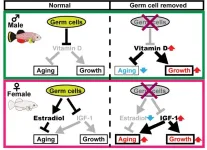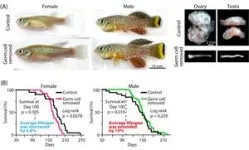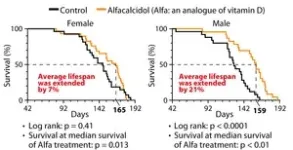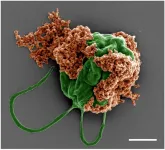(Press-News.org) Osaka, Japan – Women live longer than men. This isn’t unique to humans, either; we see this trend in a wide range of other animals. Biologists have theorized that the discrepancy in life expectancy between sexes might be partly related to reproduction, but how?
In a study published in Science Advances, researchers from Osaka University have discovered for the first time that germ cells, the cells that develop into eggs in females and sperm in males, drive sex-dependent lifespan differences in vertebrate animals.
The researchers examined aging in the turquoise killifish, a small, fast-growing freshwater fish with a lifespan of only a few months. As in humans, female killifish live longer than males. However, when the researchers removed the germ cells from these fish, they found that males and females had similar lifespans.
“After removing the germ cells, male killifish lived longer than usual and female lifespans became shorter,” explains lead author Kota Abe. “We wanted to understand how germ cells could affect males and females so differently. Our next step was to investigate the factors responsible.”
The team found that hormonal signaling was very different in females than in males. Female killifish without germ cells had significantly less estrogen signaling, which can shorten lifespan by increasing cardiovascular disease risk. The females also had significantly more growth factor signaling (insulin-like growth factor 1). This made the females grow larger while also suppressing signals within the body important for maintaining health and slowing aging.
In contrast, male killifish without germ cells had improved muscle, skin, and bone health. Interestingly, these fish had increased amounts of a substance that activates vitamin D, as well as evidence of vitamin D signaling in their muscles and skin.
Vitamin D can also be considered a hormone; while well known for keeping bones strong and healthy, it also seems to have wider positive effects throughout the body. The team’s results pointed to the possibility that vitamin D can improve longevity, leading them to test whether a vitamin D supplement could increase the lifespan of the fish.
“When we administered active vitamin D, we found that the lifespans of both males and females were significantly extended, suggesting that vitamin D signaling provides health benefits throughout the body,” explains senior author Tohru Ishitani. “Our work suggests that vitamin D signaling could influence the longevity of other vertebrates, including humans.”
The discovery that germ cells affect male and female longevity in opposing ways is an important clue in unravelling the mysterious interactions between reproduction, aging, and lifespan. It’s unclear exactly how vitamin D fits into this puzzle, but it could be part of future strategies to extend healthy lifespans.
###
The article, “Sex-dependent regulation of vertebrate somatic growth and aging by germ cells,” was published in Science Advances at DOI: https://doi.org/10.1126/sciadv.adi1621
About Osaka University
Osaka University was founded in 1931 as one of the seven imperial universities of Japan and is now one of Japan's leading comprehensive universities with a broad disciplinary spectrum. This strength is coupled with a singular drive for innovation that extends throughout the scientific process, from fundamental research to the creation of applied technology with positive economic impacts. Its commitment to innovation has been recognized in Japan and around the world. Now, Osaka University is leveraging its role as a Designated National University Corporation selected by the Ministry of Education, Culture, Sports, Science and Technology to contribute to innovation for human welfare, sustainable development of society, and social transformation.
Website: https://resou.osaka-u.ac.jp/en
END
The gender gap in life expectancy: are eggs and sperm partly responsible?
Researchers from Osaka University discover that reproductive cells drive sex-dependent differences in lifespan and reveal a role for vitamin D in improving longevity.
2024-06-12
ELSE PRESS RELEASES FROM THIS DATE:
Swimming microrobots deliver cancer-fighting drugs to metastatic lung tumors in mice
2024-06-12
Engineers at the University of California San Diego have developed microscopic robots, known as microrobots, capable of swimming through the lungs to deliver cancer-fighting medication directly to metastatic tumors. This approach has shown promise in mice, where it inhibited the growth and spread of tumors that had metastasized to the lungs, thereby boosting survival rates compared to control treatments.
The findings are detailed in a paper published on June 12 in Science Advances.
The microrobots are an ingenious combination of biology ...
Ambivalence + polarized views can promote political violence
2024-06-12
COLUMBUS, Ohio – Feeling ambivalent about a political issue might seem to be a recipe for indecision and even inaction.
But a new study suggests, surprisingly, that ambivalence can actually lead some people –especially those with polarized views – to be more supportive of extreme actions, such as violence.
The reason? Researchers found that ambivalence creates discomfort in those with extreme views by making them feel weak or insecure about their beliefs – and that can lead them to compensate for that weakness by supporting extreme actions to signal strength.
“When people have ...
Unleashing the power of metamaterials to improve MRI imaging
2024-06-12
In recent years, the field of metamaterials has experienced substantial growth, revealing exciting potential, especially in advancing magnetic resonance imaging (MRI) technology. Three new studies led by Dr. Xin Zhang, a BU College of Engineering Distinguished Professor and a professor at the BU Photonics Center, highlight the promising opportunities within this field. These studies, in collaboration with Dr. Stephan Anderson, a BU Chobanian & Avedisian School of Medicine professor of radiology, published in Advanced Science, Advanced Materials, and Science Advances, showcase innovative approaches to enhance the MRI experience for all patients. ...
USC EdTech Accelerator collaborates with Intel
2024-06-12
USC Rossier Education Technology Accelerator (USC EdTech Accelerator) announced a unique collaboration with Intel Corporation focused on supporting the use of technology for learning with a particular emphasis on supporting marginalized communities and AI.
The Partnership
The USC EdTech collaboration with Intel will provide free educational and technical assistance to learning-focused start-ups to increase the likelihood that they design viable, efficacious and scalable AI-enhanced solutions for learners. “We believe ...
What is the neural mechanism behind helping someone at your own cost?
2024-06-12
Using a unique setup, researchers from the Social Brain Lab at the Netherlands Institute for Neuroscience have researched the neural mechanism behind a universal dilemma: deciding whether to help someone else even when it involves a personal sacrifice.
We often have opportunities to give up something we care about to help others. What brain mechanisms help us make those decisions, and why do some people help more than others?
Over the years, philosophers and scientists have suggested that the extent to which a person empathizes with the distress of others influences their willingness to help.
To explore this hypothesis experimentally, Kalliopi ...
Can we withdraw treatment in post-menopausal osteoporosis?
2024-06-12
Osteoporosis is characterised by low bone mineral density and bone fragility.5 During menopause, falling oestrogen levels impair normal bone turnover, with an average reduction in bone mineral density of 10%.5 This is compounded by the age-related bone loss that occurs in both men and women. With an ageing population, post-menopausal osteoporosis represents a growing health problem.
These new data are from a case-control cohort study of over 128,000 women included in the French national claim database. The main aim was to estimate the incidence of long-term discontinuation of bisphosphonates – ...
Vexas: towards molecular and phenotypic characterization
2024-06-12
VEXAS is characterised by predominantly rheumatic and haematologic systemic involvement, and caused by somatic mutation in UBA1 – a gene encoding ubiquitin-activating enzyme 1,1,2 which is necessary for a post-translation modification that affects protein functions ranging from degradation to subcellular localisation and kinase activation.3 The syndrome was first described in 2020, but diagnosis can be challenging as the symptoms overlap with many other inflammatory conditions.1 Hot on the heels of this recent discovery, research is underway to better understand pathogenesis, clinical features, and potential treatment options.1
To support this, ...
Location, location, location – does it matter in psoriatic arthritis?
2024-06-12
Arthritis affects various joints differently, despite systemic inflammatory cues.2 In people with rheumatoid arthritis, transcriptomic variances identified in synovial fibroblasts from various joint sites have been shown to translate into joint-specific phenotypes with distinct characteristics and responsiveness to cytokines.2,3 These findings suggest that different joints may potentially respond variably to specific immunosuppressive treatments. To expand on this, Ciurea and colleagues set out to investigate whether joints at different anatomical locations in people with PsA might respond differently to treatment with a tumour necrosis ...
Stopping the march
2024-06-12
The estimated prevalence of psoriatic arthritis (PsA) in people with psoriasis ranges widely –between 6% and 42% – but in most cases, skin symptoms precede PsA, thus making skin psoriasis a model for pre-PsA.2 Assuming that there are shared pathways in the pathogenesis, it is possible that stringent treatment of moderate-to-severe psoriasis could reduce progression to clinically overt PsA.3,4 Biologic treatments are effective at controlling psoriasis, but there are no conclusive data that these treatments help prevent people from developing PsA. Several risk factors for transition have previously been identified by a EULAR taskforce.5 ...
Predicting response in treatment-naïve RA
2024-06-12
The synovial tissue inflammation seen in RA shows high degree of heterogeneity – which may be a factor in people’s variable response to treatments. We also know that distinct synovial tissue macrophage subsets regulate inflammation and remission in rheumatoid arthritis.1 The potential of high-throughput analyses has been shown, and these technologies can help dissect disease heterogeneity and identify novel biomarkers that could be used in prognosis.2
To explore this further, 373 treatment-naïve RA patients were enrolled and given an ultrasound-guided synovial tissue biopsy. The synovitis degree and synovial pathotype was then determined for ...
LAST 30 PRESS RELEASES:
Reducing social isolation protects the brain in later life
Keeping the heart healthy increases longevity even after cancer
Young adults commonly mix cannabis with nicotine and tobacco
Comprehensive review illuminates tau protein's dual nature in brain health, disease, and emerging psychiatric connections
Book prepares K-12 leaders for the next public health crisis
Storms in the Southern Ocean mitigates global warming
Seals on the move: Research reveals key data for offshore development and international ecology
Sports injuries sustained during your period might be more severe
World's first successful 2 Tbit/s free-space optical communication using small optical terminals mountable on satellites and HAPS
Can intimate relationships affect your heart? New study says ‘yes’
Scalable and healable gradient textiles for multi‑scenario radiative cooling via bicomponent blow spinning
Research shows informed traders never let a good climate crisis go to waste
Intelligent XGBoost framework enhances asphalt pavement skid resistance assessment
Dual-function biomaterials for postoperative osteosarcoma: Tumor suppression and bone regeneration
New framework reveals where transport emissions concentrate in Singapore
NTP-enhanced lattice oxygen activation in Ce-Co catalysts for low-temperature soot combustion
Synergistic interface engineering in Cu-Zn-Ce catalysts for efficient CO2 hydrogenation to methanol
COVID-19 leaves a lasting mark on the human brain
Scientists use ultrasound to soften and treat cancer tumors without damaging healthy tissue
Community swimming program for Black youth boosts skills, sense of belonging, study finds
Specific depressive symptoms in midlife linked to increased dementia risk
An ‘illuminating’ design sheds light on cholesterol
Who is more likely to get long COVID?
Study showcases resilience and rapid growth of “living rocks”
Naval Research Lab diver earns Office of Naval Research 2025 Sailor of the Year
New Mayo-led study establishes practical definition for rapidly progressive dementia
Fossil fuel industry’s “climate false solutions” reinforce its power and aggravate environmental injustice
Researchers reveal bias in a widely used measure of algorithm performance
Alcohol causes cancer. A study from IOCB Prague confirms damage to DNA and shows how cells defend against it
Hidden viruses in wastewater treatment may shape public health risks, study finds
[Press-News.org] The gender gap in life expectancy: are eggs and sperm partly responsible?Researchers from Osaka University discover that reproductive cells drive sex-dependent differences in lifespan and reveal a role for vitamin D in improving longevity.




